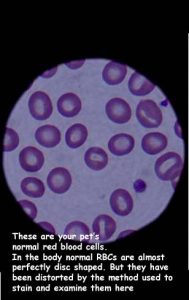Ron Hines DVM PhD
 See What Normal Blood & Urine Values Are
See What Normal Blood & Urine Values Are
 Causes Of Most Abnormal Blood & Urine Tests
Causes Of Most Abnormal Blood & Urine Tests
Mean Corpuscular Volume = MCV = The Size Of Your Dog And Your Cat’s Red Blood Cells
Your dog’s normal red blood cells (= erythrocytes = RBCs) are about 7 microns wide discs – about the same size as yours. Your cat’s RBCs are a bit smaller. When they are normal in size they are quite uniform (normocytic RBCs) and there are about 6-8 million of them in a single, small drop of your pet’s blood. When your dog or cat has certain health issues, the size of its red blood cells (their volume or MCV) can increase (=macrocytosis of its RBCs) or decrease (=microcytosis of its RBCs). Either condition changes its MCV value number. When health issues are present, your dog or cat’s red blood cells can also change in shape.
Reasons Why Might Your Dog And Cat’s MCV Might Be High (Macrocytosis):
An elevated MCV number means that your dog or cat’s red blood cells are larger than normal.
If your pet has lost a substantial amount of blood and is anemic, but its bone marrow can still make replacement red blood cells (= a regenerative anemia), those new cells are often larger than normal. That will elevate your pet’s MCV reading.
Much rarer causes of higher MCV values occur in dogs and cats. A genetic tendency to abnormal red blood cell outer wall (its cell membrane) leads to RBC swelling and increased MCV values. It has been reported in a number of breeds that include Pomeranians, malamutes and miniature schnauzers.
Feline leukemia is occasionally the underlying causes of elevated MCV (primary myelodysplasia syndrome) values in cats.
In some studies, hyperthyroidism was found to be associated with elevated MCV in cats.
A folate or vitamin B12 deficiency can cause elevated MCV. Since intestinal disorders like inflammatory bowel disease (IBD) can interfere with folate and vitamin B12 absorption. Read about IBD in dogs here and in cats here. In that situation MCV can also be abnormally high. Certain medications (e.g. trimethoprim sulfa /Bactrim®) or a cobalt deficiency can also raise MCV values.
Some dog breeds seem to naturally have larger than average red blood cells (=elevated MCV). That has been reported in poodles and greyhounds.
If your dog or cat’s blood sample partially clotted during collection due to technical issues or if a health issue caused the pet’s RBCs in the blood sample to clump or agglutinate before the test could be run, its MCV value could be falsely reported as high when read by some of the older automated blood analysis machines. Those systems can mistake a small clump of normal-size RBC for a single abnormally large one.
Red blood cells slowly swell during storage, increasing their MCV value. All blood samples need to be run promptly and refrigerated or iced immediately during transit.
Blood electrolyte disturbances (i.e. high blood sodium level = hypernatremia) can falsely elevate your dog and cat’s MCV readings in some automated blood analyzers.
Reasons Why Your Dog And Cat’s MCV Might Be Low (Microcytosis):
A lower than normal MCV number means that your pet’s red blood cells are smaller than they should be.
Puppies and kittens less than 16 weeks of age sometimes have low MCVs. Veterinarians believe that is because the iron content of their mother’s milk is quite low, and they have not had time to build up their own iron stores. That fact is a good reason to get your puppies and kittens on a nutritionally balanced solid diet as young as possible.
Anything that causes body iron levels to be low in your cat or dog can cause a low MCV reading. It could be an iron deficiency in their diet (if they are fed bizarre stuff). It could be starvation. It could be intestinal inflammation (like IBD mentioned earlier) that prevents iron absorption. It could be parasites like hookworms in your dog or in your cat. It could be chronic diarrhea or significant blood loss resulting for any reason.
Certain medications (e.g. chloramphenicol), a pyridoxine deficiency (vitamin B6) or a copper deficiency have all been associated with low MCV. If you feed your dog or cat a diet that is high in meat and liver, your pet will get all the iron, pyridoxine, B12 and folate it needs to produce normal blood.
Liver disease and altered liver blood flow (portosystemic shunts) can reduce your dog or cat’s body iron stores and result in microcytic anemia (= less & smaller than normal RBCs). So can zinc or lead poisoning.
Some akitas, shibas, and perhaps other oriental breeds seem predisposed to having slightly smaller RBCs (i.e. a low MCV). They are not anemic, and it does not appear to affect their health. In English Springer Spaniels, however, low MCV have been associated with ill health.
Too much anticoagulant (EDTA) in the blood collection tube used can shrink the size of RBCs – falsely lowering the MCV value. Lavender top collection tubes have the precise amount of EDTA in them when they are filled sufficiently with blood. It can be a challenge for your veterinarian to obtain that amount from small pets.
Abnormally low blood sodium levels can trick some automated blood analyzers into reporting a falsely low MCV.
Asiatic Dogs
Dog breeds that originate in Asia can have naturally low MCV, MCH and high-end RBC (erythrocyte) numbers. Not all do. They can also be mistaken for husky and arctic breed crosses that do not share this natural peculiarity. Asian breeds can also have higher blood potassium levels. None of these features seem to affect their health.
Complementary Tests:
All I suggested for determining the cause of low PCV, hemoglobin, iron, TIBC, Blood chemistry panel and if any clinical chemistry values are abnormal, the complementary tests suggested for each of those values need to be performed as well.
DxMe



